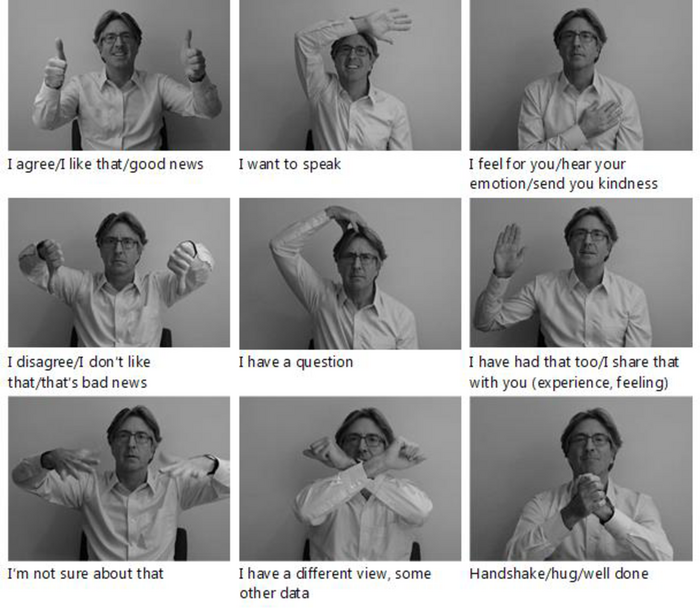Researchers have developed and demonstrated the potential benefit of a simple set of physical gestures that participants in online group video meetings can use to improve their meeting experience. Paul D. Hills of University College London, U.K., and colleagues from University College London and the University of Exeter, U.K., present the technique, which they call Video Meeting Signals (VMS™), in the open-access journal PLOS ONE on August 3, 2022.

Credit: Hills et al., 2022, PLOS ONE, CC-BY 4.0 (https://creativecommons.org/licenses/by/4.0/)
Researchers have developed and demonstrated the potential benefit of a simple set of physical gestures that participants in online group video meetings can use to improve their meeting experience. Paul D. Hills of University College London, U.K., and colleagues from University College London and the University of Exeter, U.K., present the technique, which they call Video Meeting Signals (VMS™), in the open-access journal PLOS ONE on August 3, 2022.
During the COVID-19 pandemic, online video conferencing has been a useful tool for industry, education, and social interactions. However, it has also been associated with poor mental well-being, poor communication, and fatigue.
To help overcome the challenges of online video meetings, Hills developed VMS, a set of simple physical gestures that can be used alongside verbal communication during a video meeting. The gestures—including two thumbs up to signal agreement or a hand over the heart to show sympathy—are meant to improve experiences by serving a similar function as subtle face-to-face signals, such as raised eyebrows, while being more visible in a small video setting.
To investigate the potential of VMS, Hills and colleagues first tested it among more than 100 undergraduate students. After half were trained on the technique, the students participated in two video-based seminars in groups of about 10 students each, before answering a survey about their experience.
Analysis of the survey results showed that, compared to students without VMS training, those with VMS training reported a better personal experience, better feelings about their seminar group, and better learning outcomes. Analysis of seminar transcripts also suggested that students with VMS training were more likely to use positive language.
Similar results were seen in a follow-up experiment with participants who were not students. This experiment also suggested that participants trained to use emojis instead of VMS gestures did not experience the same improved experience as participants with VMS training.
These findings suggest that VMS may be an effective technique to help overcome the challenges of video conferencing. In the future, the researchers plan to continue to study VMS, for instance by investigating the mechanisms that may underlie its effects and how to apply it for maximum benefit.
Paul D. Hills adds: “Our research indicates that there’s something about the use of gestures specifically which appears to help online interactions and help people connect and engage with each other. This can improve team performance, make meetings more inclusive and help with psychological wellbeing.”
Daniel C. Richardson adds: “Because you can’t make eye contact or pick up on subtle nods, gestures and murmurs of agreement or dissent in video conferences, it can be hard to know if people are engaged with what you’re saying. We found strong evidence that encouraging people to use more natural hand gestures had a much better effect on their experience.”
#####
In your coverage please use this URL to provide access to the freely available article in PLOS ONE: https://journals.plos.org/plosone/article?id=10.1371/journal.pone.0270399
Citation: Hills PD, Clavin MVQ, Tufft MRA, Gobel MS, Richardson DC (2022) Video meeting signals: Experimental evidence for a technique to improve the experience of video conferencing. PLoS ONE 17(8): e0270399. https://doi.org/10.1371/journal.pone.0270399
Author Countries: U.K.
Funding: MSG received support to run Experiment 2 from the University of Exeter Inclusivity Project (https://theinclusivityproject.co.uk) which is supported by the European Regional Development Fund (https://ec.europa.eu/regional_policy/en/funding/erdf/). The funders had no role in study design, data collection and analysis, decision to publish, or preparation of the manuscript.
Journal
PLoS ONE
DOI
10.1371/journal.pone.0270399
Method of Research
Experimental study
Subject of Research
People
Article Title
Video meeting signals: Experimental evidence for a technique to improve the experience of video conferencing
Article Publication Date
3-Aug-2022
COI Statement
PDH developed Video Meeting Signals (VMS) and markets workshops and training on this technique. This competing interest does not alter the authors’ adherence to PLOS ONE policies on sharing data and materials.




